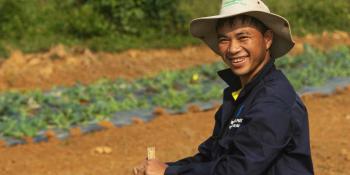Fruit tree planting is no monkey business

Almost 45 percent of the land in Sub-Saharan Africa is being cultivated. This means crops are being grown on almost half of the continent. In addition, agriculture employs 65 percent of the total population in the region, earning farmers both an income and food. So why then, are so many still going hungry each day?
We have heard the question before and we know that answers do not come easy.
Yet it was exactly these questions and answers which were explored at the World Agroforestry Centre's side event at the Africa Agriculture Science Week (AASW). During the session, panelists found themselves confronted by an audience who didn't hold back, as they spoke about the links between fruit trees and food security under the topic of ‘Agroforestry for food and nutritional security in Africa’.
Thinking that planting fruit trees was a straightforward issue going into the event, I quickly realized that this was certainly not the case!
The audience had many questions for our panelists: what types of fruit trees can be useful for farmers? How can farmers access both tree-seedlings and markets to sell their fruits? Are they being taught how and when to plant the trees? What about pests and diseases from new tree species - how can they deal with that?
Much to take into consideration, in other words!
Learn more: Watch Agroforestry video from lower Nyando, Kenya
Fruit trees can be good, especially for smallholder farmers in Africa, and certainly when we are trying to ensure food security on a continent that suffers from depleted soils, deforestation and climate change - just to mention a few of the recurrent challenges. But accessing, learning and building a fruit tree orchid in parallel to farming activities in your field, takes time. And can be scary...
Can trees be scary?
How can trees be scary, you might wonder? As Zac Tchoundjeu of ICRAF explained, in his work to encourage fruit tree planting he had encountered a group of women who firmly said they didn't want to plant trees on their farms. Initially, these women farmers said this was due to tradition: ‘women shouldn’t plant trees’. However later, it was found out that they feared these trees would overshadow their plants and perhaps reduce yields. An understandable reaction, but one driven by fear and can have negative impacts.
By overcoming barriers like fear, fruit trees can become one solution to reduce the number of undernourished children, which was one of the take-home messages from the event. Providing fruits, while increasing farm productivity, generating water and improving soils, can’t be a bad investment!
But fruit tree-planting is no monkey-business, as moderator, Professor August Temu, discussed in his initial speech. It is serious business. Learning what trees work for what regions and how they can be used to increase productivity, rather than deplete soils and yields, is a lengthy process. But one which holds a lot of promise for building climate resilience while securing food for tomorrow.
Learn more: How growing mangoes can make a difference in a farmer's life



